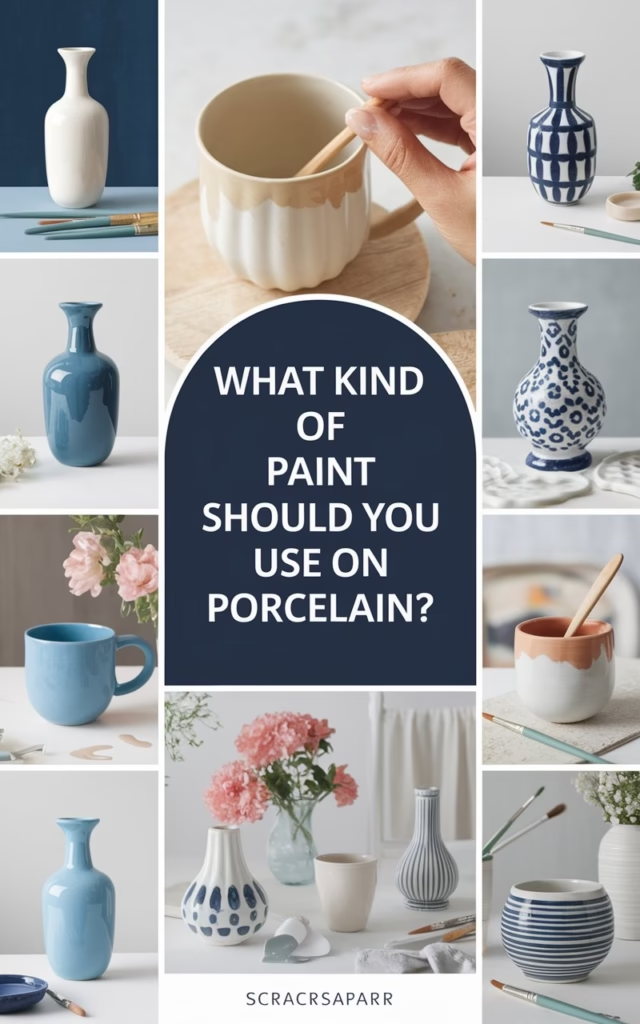Porcelain is renowned for its smooth, glossy finish and timeless elegance. Whether you’re looking to breathe new life into an old teapot, create a one-of-a-kind decorative plate, or add a personal touch to a bathroom fixture, painting on porcelain can be both a creative challenge and a rewarding project. In this guide, we explore the best types of paint for porcelain, how to prepare your surface for optimal adhesion, and tips for achieving durable, beautiful results.
Understanding Porcelain and Its Challenges
Porcelain is a type of ceramic that has been fired at high temperatures to produce a hard, non-porous, and glossy finish. This very smooth surface, however, makes it difficult for traditional paints to adhere. Without proper preparation and the right type of paint, your design may flake or peel off with minimal use.
Key Challenges:
- Low Porosity: The glazed finish repels most water-based paints, reducing adhesion.
- Smooth Surface: Paint may slide off or create an uneven finish if it doesn’t “grab” the surface.
- Functional Requirements: If your painted object is intended for everyday use (e.g., a teapot or dish), the paint must be non-toxic and ideally dishwasher safe.
Types of Paint Suitable for Porcelain
Several paint options exist for porcelain projects. The right choice depends on your project’s function and how permanent you need the design to be.
1. Porcelain Enamel (Overglaze) Paint
Porcelain enamel paints are specially formulated to adhere to glazed surfaces. These paints are often used by professionals and require kiln or oven firing to bond permanently with the porcelain.
- Pros:
- Highly durable and resistant to scratching and washing.
- Creates a glossy, professional finish.
- Cons:
- Requires specialized equipment (kiln or oven).
- More involved process and generally used for decorative or functional wares meant to last.
2. Acrylic Porcelain Paints
Many modern craft brands offer acrylic-based paints designed for ceramics and porcelain. These paints often come in the form of markers, pens, or even bottle paints.
- Pros:
- Easy to apply with brushes or paint pens.
- Great for DIY projects and detailed work.
- Available in a variety of colors and finishes.
- Cons:
- May not be as durable as kiln-fired enamels if the item is subject to heavy use.
- Some acrylic formulations might require a bonding primer for better adhesion.
3. Multi-Surface or Ceramic-Specific Acrylics
Certain multi-surface acrylic paints are designed to work on non-porous surfaces like glass and porcelain. They often offer improved adhesion and can be cured (by air drying or baking in a conventional oven) to become more permanent.
- Pros:
- Versatile and user-friendly for DIYers.
- Often non-toxic and suitable for items that come in contact with food.
- Cons:
- May require careful surface preparation and proper curing to maximize durability.
Preparing Your Porcelain Surface
Preparation is the key to success when painting on porcelain. Here’s a step-by-step guide:
- Clean Thoroughly:
Wash your porcelain item with warm, soapy water to remove any dust, grease, or residue. Rinse well and let it dry completely. For best results, wipe the surface with rubbing alcohol to remove any lingering oils. - Roughen the Surface:
Lightly sand the glazed surface with fine-grit (400–600 grit) sandpaper. This creates tiny abrasions that allow the paint to “grab” the smooth porcelain. Wipe off all dust with a clean, damp cloth and let it dry. - Apply a Bonding Primer (Optional):
For projects that require extra durability, consider using a primer made for non-porous surfaces. A clear, acrylic bonding primer can improve adhesion for acrylic porcelain paints. Follow the manufacturer’s instructions regarding drying times.
Painting Techniques
Using Porcelain Enamel Paint
If you’ve chosen a porcelain enamel:
- Application: Use high-quality brushes or enamel markers to apply your design.
- Curing: After the paint has dried to the touch, place your piece in a conventional oven (or kiln, if available) and cure according to the product instructions. This process fuses the paint with the porcelain, making it durable and dishwasher safe.
Using Acrylic Porcelain Paints or Multi-Surface Acrylics
For acrylic options:
- Brush or Pen Application: Use fine-tip paint pens for detailed work or a soft brush for broader strokes.
- Layering: Apply multiple thin layers rather than one thick coat. Allow each layer to dry fully before applying the next to build up vibrant, lasting color.
- Curing (Optional): Some acrylic paints benefit from a gentle bake in the oven (typically at low temperatures around 300°F or 150°C for 30–60 minutes) to improve water resistance. Check the paint label to see if baking is recommended.
Drying, Curing, and Sealing
- Drying Time: Allow your painted piece to dry in a dust-free area. Acrylic-based paints typically dry within a few hours, but full curing may take up to 24 hours.
- Oven Curing: For paints that allow or require it, bake the piece in an oven after the final coat. Always follow the manufacturer’s recommended temperature and time guidelines.
- Sealing: To further protect your artwork—especially if it will be handled frequently—apply a clear, non-toxic sealant designed for ceramics. This extra layer of protection can enhance durability and maintain the finish over time.
Tips and Tricks
- Test First: Always test your chosen paint on a small, inconspicuous area or on a spare porcelain piece. This will help you understand how the paint adheres and dries on your specific surface.
- Use Thin Layers: Avoid applying too much paint at once. Thin layers dry evenly and are less likely to peel or crack.
- Follow Instructions: Each product may have its own specific instructions for application, drying, and curing. Always read and adhere to these guidelines.
- Safety First: When baking painted porcelain, use proper oven-safe equipment and allow the item to cool completely before handling. Also, ensure your workspace is well-ventilated if you’re using products with strong fumes.
Conclusion – What Kind of Paint Should You Use on Porcelain?
Painting on porcelain is a fantastic way to personalize and update everyday objects, turning them into unique works of art. By selecting the right type of paint—whether a durable porcelain enamel or an acrylic designed for non-porous surfaces—and following careful preparation and application techniques, you can achieve a beautiful, lasting finish. Experiment with different methods, and don’t be afraid to test your process on a scrap piece first. With patience, practice, and proper care, your painted porcelain projects can become treasured, one-of-a-kind pieces that add character and charm to your home.
Happy painting!

Haris Virk is the creative force and expert content strategist behind ScrapSafari.com. As an accomplished writer and designer, Haris leads the development of innovative content and visually stunning images that captivate audiences. His extensive experience in crafting engaging articles and unique design ideas makes him a pivotal contributor to ScrapSafari’s success.
Haris’s keen eye for aesthetics and trend forecasting ensures that every piece he produces not only informs but also inspires readers. His proficiency extends to mastering Pinterest strategies, where his thoughtfully crafted pins drive significant traffic and amplify the site’s reach.
With a passion for creativity and a deep understanding of content dynamics, Haris Virk brings a distinctive blend of originality and strategic thinking to the ScrapSafari team, solidifying its place as a go-to source for design, ideas, and inspiration.


